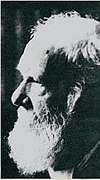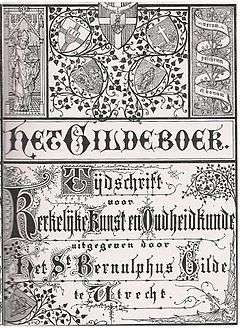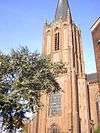Wilhelm Victor Alfred Tepe
Wilhelm Victor Alfred Tepe (1840–1920) was a Dutch architect. He is considered an important and influential representative of Gothic Revival architecture in the Netherlands during the 19th century. He designed and built many churches as well as other buildings, especially in the territory of the Archdiocese of Utrecht.
Wilhelm Victor Alfred Tepe | |
|---|---|
 | |
| Born | 24 November 1840 Amsterdam, Netherlands |
| Died | 23 November 1920 (aged 79) |
| Resting place | Düsseldorf, Germany |
| Nationality | Dutch |
| Occupation | Architect |
| Employer | St. Bemulphus Guild |
| Known for | Architect of church exteriors |
| Spouse(s) | Maria Josepha Savels Alexandrina |
| Children | 2 sons |
| Parent(s) | Father: Friederich Anton Tepe Mother: Maria Anna Sternenberg |


Tepe was a key member of the Guild of St. Bernulphus, a Dutch secret society and trade union. He built and remodeled mostly in brick and used natural stone only in the later part of his career. He had four distinct time periods of architectural style in his career. He was primarily a Catholic ecclesiastical architect and worked mostly for the church. His style of designs were carried forward by other future architects.
Early life
Tepe was the son of German immigrants and born in Amsterdam on 24 November 1840. His father, Friederich Anton Tepe, was a textile merchant. His mother's name was Maria Anna Sternenberg.[1]
Tepe grew up and received his primary education in the city of Delft in the province of South Holland, Netherlands. After graduating from Saint Willibrordus gymnasium in Katwijk in 1858 he first went to Saint Willibrord College in the town of Katwijk on the Rhine in South Holland. Then from 1861 to 1864 he studied construction at the college of Bauakademie in Berlin. Additionally he also studied medieval architecture, especially that of the French architect and expert Eugène Viollet-le-Duc. Tepe afterwards went to Münster in western Germany for mathematical studies.[1]
Career
Tepe's first serious work in his career was when he joined German Gothic Revival architect Vincenz Statz in Cologne.[2] There from 1865 into 1866 he was involved with the completion of the Cologne Cathedral. Tepe then traveled for a short time with Statz and ultimately returned to Amsterdam in 1867. While there met Gerard van Heukelum, then chaplain at St. Catherine's Cathedral in Utrecht. In 1871 Tepe moved to Utrecht and started working for Heukelum, who had become an architect and founded the Guild of St. Bernulphus. Tepe received some assignments from Heukelum on village schools and rectories.[1]
Tepe built or worked on churches in the period from 1871 to 1905 as a key member of the Guild of St. Bernulphus.[3] Brick was the material he chose instead of natural stone in constructing Dutch brick gothic architecture.[4] He took late-Gothic 15th- and 16th-century designs of the Lower Rhine region (Nederrijns) and Westphalia as "School of Utrecht" examples to work from for the exterior of the churches he was working on.[5] Other members of the Guild of St. Bernulphus provided the interior parts of these churches in construction. Friedrich Wilhelm Mengelberg was the most influential of the interior designers from the guild and Tepe worked closely with him. From 1872 under Archbishop Andreas Ignatius Schaepman, until his death in 1882, Tepe had a virtual monopoly on the building of churches in the Diocese of Utrecht.[1]
Architectural style
Tepe's architectural-style changed little throughout his career. There are four times in his career where some deviation in style is shown. His church designs between 1871 and 1876 were rarely decorated in the time period of his first phase. He increased his decorations from 1876 to 1890 in a second phase of his architectural style. In a third phase, of a time period of 1890 to 1900, he built several hall churches which represented a centralizing tendency.[6]
Tepe reverted to some of his original church designs after 1900 in a fourth phase of his architectural style. After 1900 he sometimes built churches in Germany, especially after some of his works were published in the authoritative German periodical Zeitschrift für christliche Kunst. He designed and built a slightly different style, which regularly made use of stone. For example, the church he built in Bawinkel was largely of sandstone.[6]
Tepe was primarily a Catholic ecclesiastical architect. He designed orphanages, monasteries, schools, and rectories.[7] He did not work on public buildings and rarely on residential structures. Tepe's most important works include Saint Andreasgasthuis in Utrecht (1873),[8] the Roman Catholic Orphanage and Oudeliedengesticht in Utrecht (1875), old people's homes in Utrecht built from 1875–1877, and the Mariënburg in Bussum (1889).[6] Many of the Catholic churches Tepe designed took on nicknames rather than their official names, like De Krijberg - an Amsterdam church that he designed in 1884 that was officially the Franciscus Xaveriuskerk.[9]
Tepe was the leader of a clearly identifiable direction within the Dutch Gothic Revival architecture.[10] His churches were characterized by a simple but often slender build and where possible with high towers.[11] He nearly always had a three-aisled design, even in small churches. [12] The exteriors of his churches were usually missing ornaments, except in the Rhineland, where niches, balustrades and pinnacles of decorated gables were applied in a number of churches. Tepe even applied flying buttresses on some rare occasions. His influence of the Dutch Gothic Revival architecture was eventually taken over by others like J.W. Boerbooms and Wolter te Riele.[6]
Personal life
Tepe married Maria Josepha Savels Alexandrina on 24 May 1870. They had two sons. Maria died 13 July 1897. Tepe remarried on 15 December 1904 to Wilhelmine Margareta Kracht. There were no children from this marriage.[6]
Later life and death
Tepe moved to Germany in 1905 with Kracht and designed churches there until his death in 1920. He died in Düsseldorf, a day short of being 80 years old.[6]
Important works
The following well known churches Tepe designed.
- 1874–1875 Jutphaas: St. Nicholas Church (nl)
- 1874–1876 Arnhem: St. Martin's Church (nl)
- 1875–1877 Utrecht: St. Jerome, orphanage and nursing home (nl)
- 1876–1877 Utrecht: St. Willibrord Church (nl)
- 1878–1879 Schalkwijk: St. Michael's Church
- 1880-1881 Harlingen: St. Michael's Church (nl)
- 1881–1883 Amsterdam: St. Francis Xaverius Church (nl)
- 1884-1885 Oosterbeek: St. Bernulphuskerk (nl)
- 1885–1887 IJsselstein: St. Nicholas Church (nl)
- 1891-1892 Raalte: Basiliek van de Heilige Kruisverheffing (nl)
- 1898 Neede: St. Cecil's Church
- 1899-1901: Utrecht: St. Martin's Church (nl)
Other examples
- St. Martin's Church (nl)
(Arnem) 
H. Exaltation (nl)
(Raalte)St. Werenfridus Church (nl)
(Workum)St. Ludgeruskerk (nl)
(Balk)
St. Gregory Church (nl)
(Bredevoort)
St. Nicholas Church (IJsselstein)
See also
References
- Looyenga 1985, pp. 562.
- Muller 2013, p. 255.
- Jokilehto 2017, p. 399.
- Remery 2011, p. 9.
- Filedt 2014, p. 62.
- Looyenga 1985, pp. 563.
- Rossum 1901, p. 94.
- Hirsch 1908, p. 196.
- Duncan 2013, p. 99.
- Cortjaens 2008, p. 168.
- Allard 1883, p. 158.
- Leeuwen 1908, pp. 98-99.
Sources
- Allard, Herman Jozef Petrus Hugo (1883). The St. Francis Xaverius Church or Krijtberg in Amsterdam. Drukkerij der St. Paulus-Vereeniging.
- Cortjaens, Wolfgang (2008). Historism & Cultural Identity in Rhine-Meuse Region / Tensions Between Nationalism & Regionalism in the 19th Century. Leuven University Press. ISBN 9789058676665.
- Duncan, Flona (2013). Top 10 Amsterdam. Springer Netherlands. ISBN 9789401532679.
- Filedt, J.P. (2014). Netherlands Quarterly for History of Art. Springer Netherlands. ISBN 9789401532679.
- Hirsch, Fritz (1908). Journal of History of Architecture. C. Winter.
- Jokilehto, Jukka (2017). History of Architectural Conservation. Taylor & Francis. ISBN 9781317266518.
- Leeuwen, A.J. (1908). De Katholiek (Dutch). Van Rossum.
- Looyenga, J. W. (1985). Biographical Dictionary of the Netherlands 2 (Dutch). ’s-Gravenhage: Nijhoff. ISBN 90-247-2278-0.
- Muller, Sheila D. (2013). Dutch Art - An Encyclopedia. Taylor & Francis. ISBN 9781135495749.
- Remery, Michel (2011). Mystery and Matter/ Relationship Between Liturgy & Architecture. Brill. ISBN 9789004182967.
- Rossum, J.R. (1901). Archive for history of the Archdiocese of Utrecht, Part 27 (Dutch). Van Rossum.